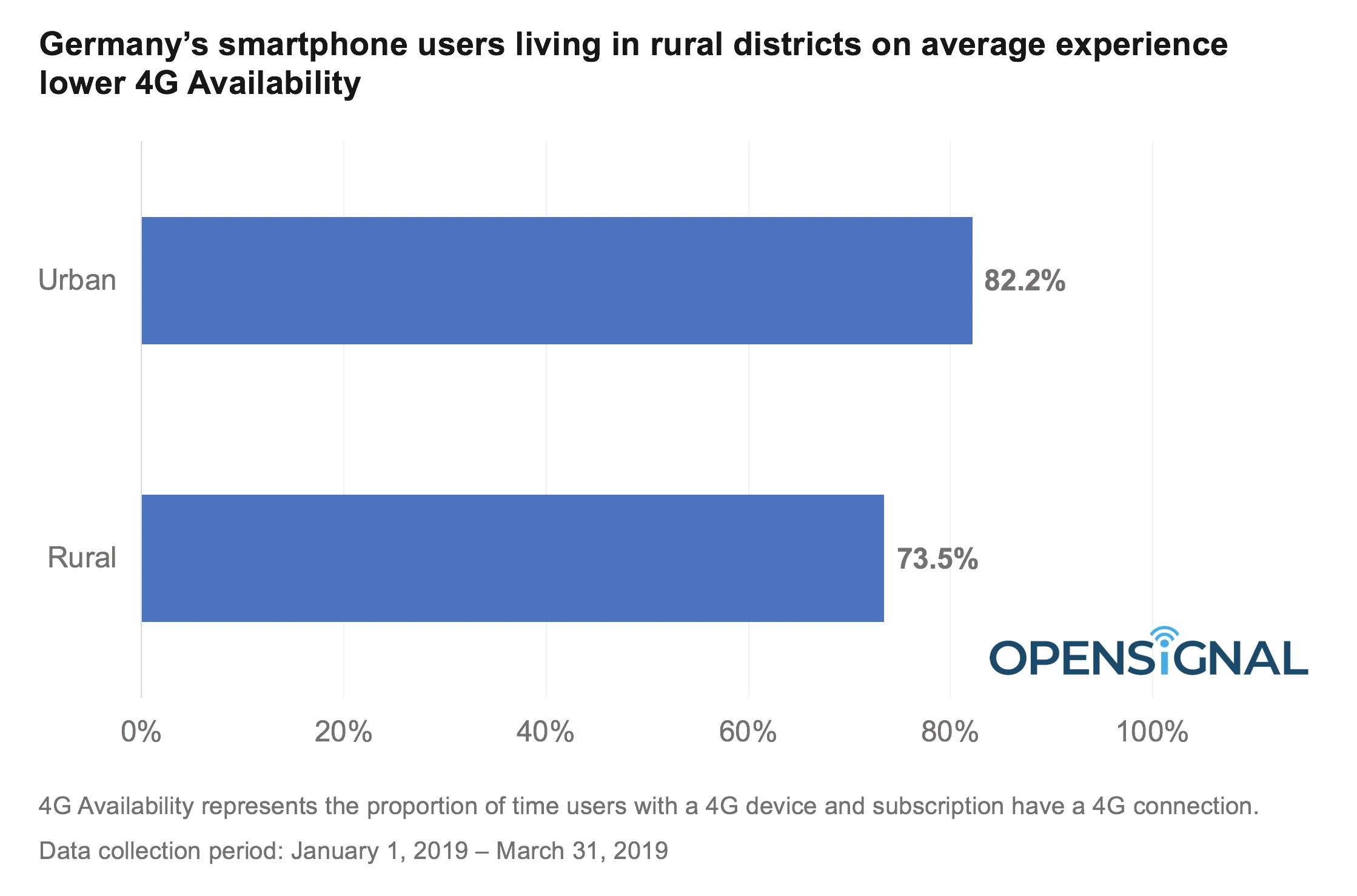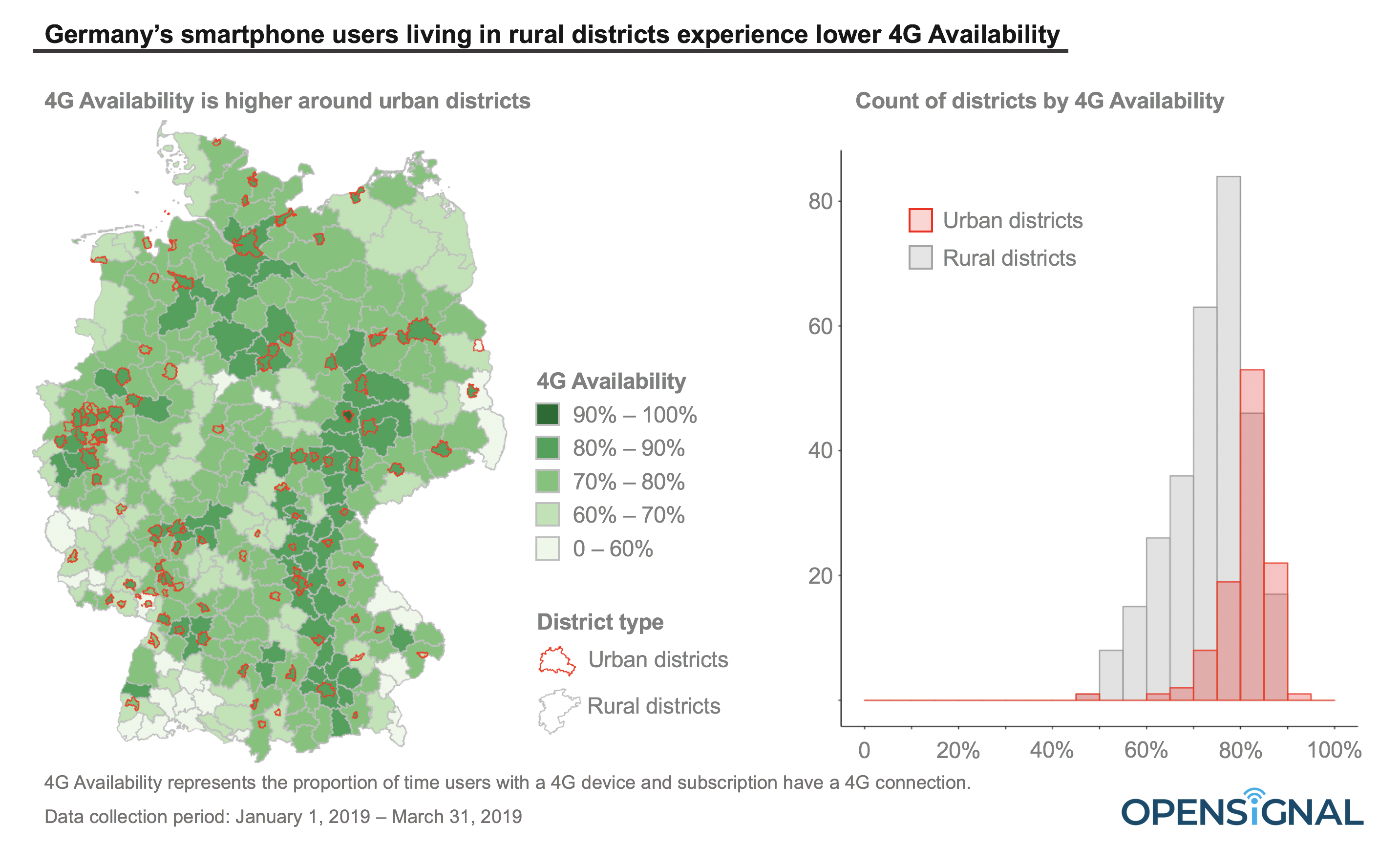In the first quarter of 2019, our smartphone users in Germany could on average access the internet over 4G networks 82.2% of the time when they were in the urban districts, but this dropped to just 73.5% of the time in the rural districts. Our users in rural areas spend more than one-quarter of their time connected to 2G and 3G networks.
Opensignal analyzed the proportion of time our users with a 4G device and subscription had a 4G connection — 4G Availability — in Germany’s 401 administrative districts, across all mobile operators. We found that our users in Halle were the only ones to enjoy connectivity to 4G networks more than 90% of the time, while our users in 86 rural districts still experienced 4G Availability lower than 70%.

In our map below, we observed higher 4G Availability around urban districts, and more generally in the large urban areas around big cities and industrial centers like Cologne, Munich, Nuremberg, Hannover and Leipzig.

On the other hand, our smartphone users in the rural districts were more likely to experience lower 4G Availability, as shown in the above chart. However, our map seems to suggest that the closer our users were to urban districts, the higher 4G Availability they enjoyed. In fact, the colors in our map gradually become lighter the further you move away from the urban districts reaching the lowest 4G Availability scores in rural districts furthest from the urban areas — as we can see for example in the South-Western part of the Baden-Württemberg region (the Black Forest and the Bavarian Alps).
Out of the 401 districts, only Halle saw a 4G Availability score above 90%, while most of Germany's districts — both urban and rural — scored between 70% and 90%. Among the 90 districts that scored a 4G Availability lower than 70%, only four were urban districts, though it was one of those four — Frankfurt an der Oder — which saw the lowest 4G Availability of all, at 47.5%.

Germany remarkably managed to stay out of all top-20 rankings in our five key award metrics in our latest global benchmarking of mobile experience. It collected its worst ranking in 4G Availability, where it ranked below less-developed Central European markets such as Bulgaria, the Czech Republic and Poland. In fact, our users in Germany were able to connect to 4G networks only 76.9% of the time during the first 90 days of 2019. While we saw significant improvement in comparison to our 2018 State of LTE report, where the country scored a 4G Availability of 65.7%, it is still more than 20 points behind South Korea, our 4G Availability leader, whose latest score reached 97.5%.
Not only do smartphone users in Germany experience one of the lowest 4G Availability scores in Europe, but our data shows that millions of 4G users, mostly living in rural districts, are not able to connect to 4G networks up to half of the time when they use their smartphones.
In our recent analysis of Germany’s spectrum use, we found that mobile operators deployed higher spectrum bands in more densely populated areas, while many rural areas only had access to 4G services on sub-1 GHz bands. The concentration of mobile infrastructure in the urban areas likely explains the 4G Availability difference we observed between urban and rural districts.
With an ongoing 5G spectrum auction, Germany’s mobile operators are likely planning their future 5G deployments, but many rural users in Germany are probably not concerned with how fast 5G will be. They are more likely to be wondering if they will be able to access 4G networks when they will next use their smartphones.
Opensignal Limited retains ownership of this insight including all intellectual property rights, data, content, graphs & analysis. Reports and insights produced by Opensignal Limited may not be quoted, reproduced, distributed, published for any commercial purpose (including use in advertisements or other promotional content) without prior written consent. Journalists are encouraged to quote information included in Opensignal reports and insights provided they include clear source attribution. For more information, contact [email protected].
